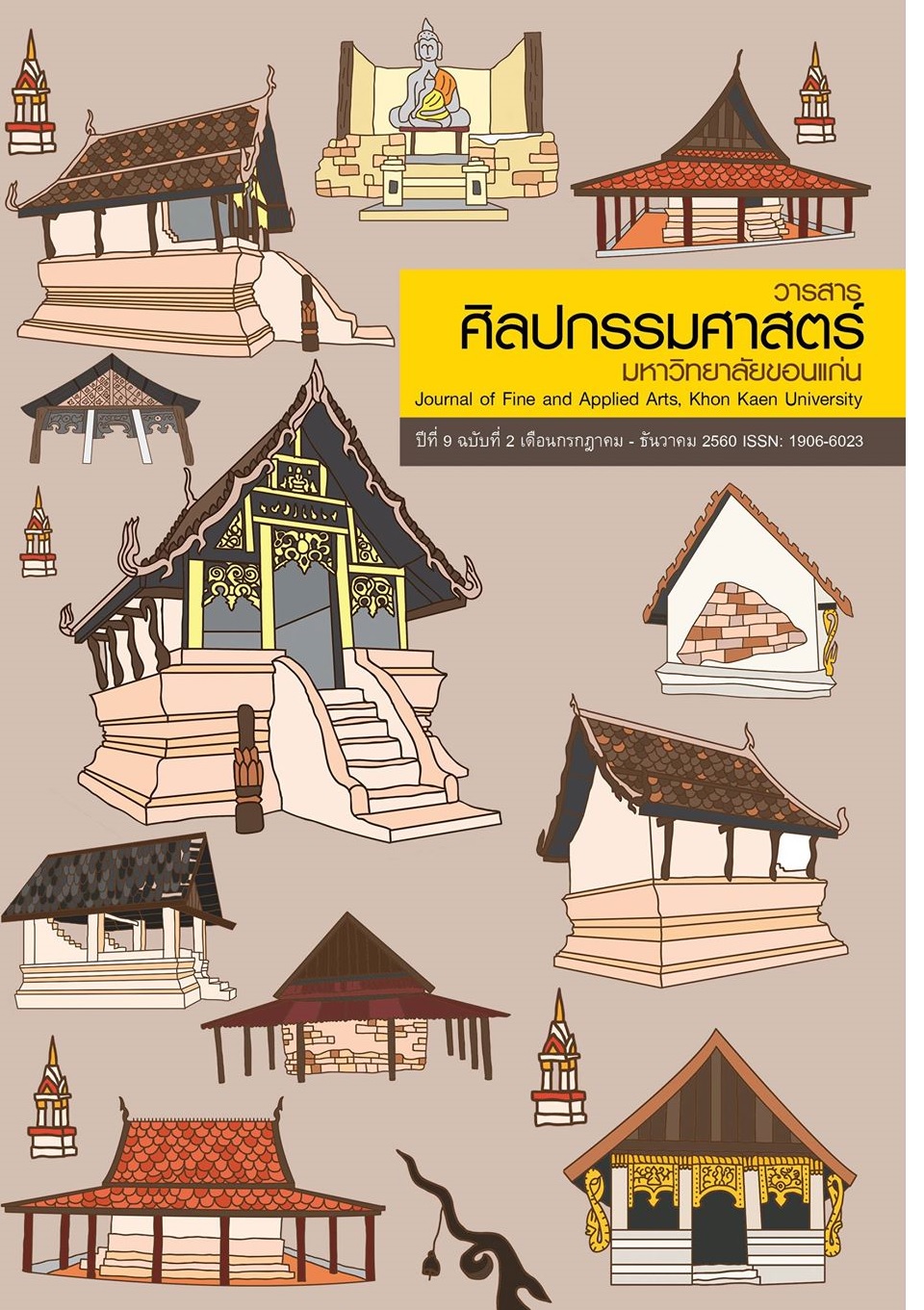ปัจจัยที่มีผลต่อการเปลี่ยนแปลงความเชื่อในพิธีกรรมการเหยาเลี้ยงผีของชาวผู้ไท ตำบลกุดหว้า อำเภอกุฉินารายณ์ จังหวัดกาฬสินธุ์ The Factors Effecting to Changes the Belief of the Yao Liang Phi Ritual of the Phu Thai People in Kudwa Sub-District, Kuchin
Main Article Content
Abstract
ปัจจัยที่มีผลต่อการเปลี่ยนแปลงความเชื่อในพิธีกรรมการเหยาเลี้ยงผีของชาวผู้ไท ตำบลกุดหว้า อำเภอกุฉินารายณ์
จังหวัดกาฬสินธุ์ มีวัตถุประสงค์ในการศึกษา 1) เพื่อศึกษาประวัติและความเป็นมาของพิธีกรรมการเหยาเลี้ยงผีของชาวผู้ไท 2) เพื่อศึกษาสภาพปัจจุบันของพิธีกรรมการเหยาเลี้ยงผีของชาวผู้ไท 3) เพื่อศึกษาปัจจัยที่มีผลต่อการเปลี่ยนแปลงความเชื่อในพิธีกรรมการเหยาเลี้ยงผีของชาวผู้ไท ตำบลกุดหว้า อำเภอกุฉินารายณ์ จังหวัดกาฬสินธุ์ เป็นการศึกษาโดยใช้กระบวนการวิจัยเชิงคุณภาพ โดยมีการศึกษา ดังนี้ แบ่งกลุ่มเป้าหมายออกเป็น 3 กลุ่ม คือ 1. กลุ่มผู้รู้ จำนวน 10 คน 2. กลุ่มผู้ปฏิบัติ จำนวน 20 คน และ3. กลุ่มผู้เกี่ยวข้อง จำนวน 20 คน ซึ่งเป็นคนที่อาศัยในพื้นที่ตำบลกุดหว้า อำเภอกุฉินารายณ์ จังหวัดกาฬสินธุ์ เครื่องมือที่ใช้ในการวิจัย ประกอบด้วย แบบสำรวจ แบบสังเกต แบบสัมภาษณ์ และการสนทนากลุ่ม แล้วรวบรวมนำมาวิเคราะห์ด้วยทฤษฎีโครงสร้างหน้าที่นิยม ทฤษฎีการแพร่กระจายทางวัฒนธรรม ทฤษฎีปฏิสัมพันธ์เชิงสัญลักษณ์ ทฤษฎีเทคโนโลยี ทฤษฎีการขัดแย้ง ทฤษฎีวิวัฒนาการ นำเสนอโดยใช้วิธีพรรณนาวิเคราะห์ จากการศึกษาพบว่า การเกิดพิธีกรรมการเหยาเลี้ยงผีแบ่งออกเป็น 3 ช่วงเวลาช่วงแรกเมื่อปี พ.ศ. 2399 ที่บ้านกุดหว้า เนื่องจากมีผู้คนได้อพยพมาจากเมืองวัง มายังบ้านกุดหว้า แล้วชาวบ้านเกิดโรคภัยไข้เจ็บ พยายามรักษาด้วยสมุนไพรแต่ก็ไม่หายจึงพาไปหาหมอส่อง พบว่ามีผีต้องการมาอยู่ด้วย จึงทำพิธีรับผีลงมา ในแต่ละปีต้องมีการจัดพิธีกรรมขึ้นเพื่อเป็นการเลี้ยงขอบคุณผีที่มาคอยปกปักรักษา และได้ปฏิบัติสืบต่อกันมาเรื่อยๆจนถึงช่วงที่ 2 เมื่อปี พ.ศ. 2432 ผู้คนได้ออกมาตั้งหมู่บ้านแห่งใหม่ คือบ้านโคกโก่ง เมื่อปี พ.ศ. 2432 บ้านวังมน พ.ศ. 2450 บ้านห้วยแดงและบ้านขุมขี้ยาง เมื่อปี พ.ศ. 2453 ซึ่งในแต่ละหมู่บ้านจะมีหมอเหยาเกิดขึ้น จนมาถึงช่วงที่ 3 เกิดบ้านนาไคร้ เมื่อปี พ.ศ. 2513 พอมีหมู่บ้านแห่งใหม่ก็มีหมอเหยาปรากฏขึ้น และยังคงมีความเชื่อมาจนถึงปัจจุบัน แต่ปัจจุบันพบว่า พิธีกรรมการเหยามีการเปลี่ยนแปลงไปจากเดิม สิ่งที่เกิดการเปลี่ยนแปลงมากที่สุดโดยเรียงลำดับ ได้แก่ ผู้เข้าร่วมในพิธีกรรม พบว่าในปัจจุบันมีจำนวนลดน้อยลงเมื่อเปรียบเทียบกับอดีต เครื่องแต่งกาย พบว่ามีการเปลี่ยนแปลงไป เช่น เสื้อ ผ้าถุง กางเกง สไบ ต่างหู เครื่องดนตรี พบว่ามีการเพิ่มชนิดของเครื่องดนตรีเข้ามาคือ กลอง ฉิ่ง และเครื่องขยายเสียง และนอกจากนี้ยังมีการเปิดเครื่องเล่นซีดีแทนการใช้คนเล่น วัน เวลา และสถานที่ในการประกอบพิธีกรรม พบว่าวัสดุที่ใช้ในการทำผามหรือปะรำพิธีจะใช้วัสดุสมัยใหม่ ใช้เต้นท์กางเป็นหลังคา และใช้ผ้าแสลงกั้นบริเวณปะรำพิธี เครื่องคาย พบว่าใช้เหล้าขาวแทนเหล้ากลั่น เทียนไขที่ทำมาจากพาราฟินแทนขี้ผึ้ง และกรวยที่ทำจากใบตองกล้วยแทนใบขนุน เครื่องเล่น พบว่าอดีตใช้โอ่งแต่ปัจจุบันใช้ถังพลาสติกเป็นอุปกรณ์ที่ใช้ในการรองน้ำไว้สำหรับนำช้างไปเล่น เวทมนต์คาถาหรือบทสวด พบว่าได้มีการจดบันทึกบทสวดออกมาเป็นลายลักษณ์อักษรและยังมีการนำเครื่องโทรศัพท์มือถือมาอัดเสียงแม่เมืองขณะที่กำลังประกอบพิธีกรรม ขั้นตอนในการประกอบพิธีกรรม พบว่าลดน้อยลง มีบางขั้นตอนในอดีตที่ขาดหายไป จากสภาพการเปลี่ยนแปลงที่เกิดขึ้นเกิดจากปัจจัยทั้งภายในและภายนอก ปัจจัยภายในที่ก่อให้เกิดการเปลี่ยนแปลงมากที่สุดคือ ด้านคติความเชื่อ เนื่องจากสภาพสังคม สิ่งแวดล้อมในปัจจุบัน ทำให้ความเชื่อมีการเปลี่ยนแปลงไป ส่งผลไปยังค่านิยมสมัยใหม่ ด้านประสบการณ์มีการเรียนรู้เพิ่มมากขึ้น จึงทำให้รู้จักการปรับตัวเพื่อความอยู่รอดในสังคม ส่วนปัจจัยภายนอกที่ก่อให้เกิดการเปลี่ยนแปลงมากที่สุดคือการเผยแพร่ทางวัฒนธรรมจากสังคมอื่นเข้ามา รองลงมาคือด้านการค้นพบและการประดิษฐ์ สร้างองค์ความรู้ใหม่ขึ้นมาจึงก่อให้เกิดทางด้านเทคโนโลยีสมัยใหม่เพื่ออำนวยความสะดวกให้แก่ผู้คนและยังส่งผลไปทางด้านเศรษฐกิจที่กำลังประสบอยู่ในปัจจุบัน
The aims of this research are: 1) to study the history and the background of the Yao Liang Phi ritual of the Phu Thai people. 2) to study the current status of the Yao Liang Phi ritual of the Phu Thai people and 3) to study the factors effecting to changes the belief of the Yao Liang Phi Ritual of the Phu Thai people in Kudwa sub-district, Kuchinarai district, Kalasin province. This research is a qualitative research. The study by target group is separated into 3 group. 1. The knowledge group 10 people, 2. The practitioner 20 people, and 3. the relevant 20 people. Which is people live in area Kudwa sub-district, Kuchinarai district, Kalasin province. using the data collected from the documents and field study by surveys, observations, and the interview from 50 people who are experts, the practitioners, and other people related to the ritual. The data of this research was presented using descriptive analysis along with the images.
The result of the research shows that the Yao Liang Phi ritual is separated into 3 periods. The first period was in the year 1856 in Kudwa village. At the time, people migrated from Muang Wang to Kudwa village and was struck by a sickness and tried to heal themselves with herbs but the sickness wasn’t healed. The issue was then taken to the medium and was found out that the sickness was caused by the fact the there’s a spirit that wanted to come and stay. A ritual was put in place to receive the spirit. Each year, a ritual will be held to thank the spirit for its protection and the ritual was carried on up until the second period in the year 1889. People had migrate and established new villages; Khok Gong village in the year 1889, Wang Mon village in the year 1907, and Huay daeng and Khoom Khi Yang village in the year 1910. In each village, there will be “Maw Yao” or the shaman to perform the ritual. The third period started when Na Khrai village was established in the year 1970. New villages emerge alongside the shamans and the belief was carried on until today. However, it was found that the Yao ritual had changed from its original status. The major change are the participants in the ritual the present less number when compare former, the costumes have change such as shirts sarong pants breast cloth earring, the musical instruments have type add come in are drum cymbal and amplifier. And also open the CD player instead people play, the date and time, the place where the ritual will be held the materials used to make denounced or marquee ceremony the use of modern materials. Tent camping is a roof and use cloth slang fenced marquee ceremony, the objects involved in the ritual use white wine instead of liquor distillery. Candles made from paraffin instead wax. Cone made of banana leaves instead jackfruit leaves., the spells or the chants former use blister but present use plastictank the device uses a secondary water for bring elephants to play., magic spells or chants have record magic spells is written form and use telephone transcribe maremueng while performing the ritual. and the steps in performing the ritual less steps in the past there are some steps missing. From the changes that happen both from the internal and the external factors, the internal factors that contribute the most to the changes are the belief, the current social and environmental state which contribute to the changes in the belief. These changes result in a more modern value. The new experiences led to more knowledge that helps the people to survive in the society. As for the external factors that contribute the most to the changes are the dissemination of other culture and the discoveries and the innovations. These new knowledges led to newer technologies that provide more convenient to the people which will have an impact on the economy being faced today.
Article Details
Content and information in articles published in the Journal of Fine and Applied Arts of Khon Kaen University is regarded as the opinion and sole responsibility of the author(s) directly; therefore, editors are not obliged to agree to or share any responsibility with regard to the content and information that appears within these articles.
All articles, information, content, image, etc. that have been published in the Journal of Fine and Applied Arts of Khon Kaen University is the copyright of the Journal of Fine and Appllied Arts of Khon Kaen University. Any person or organization who wishes to distribute all or parts of the articles for further dissemination or other usage must first receive permission from the Journal of Fine and Applied Arts of Khon Kaen University before proceeding to do so.

